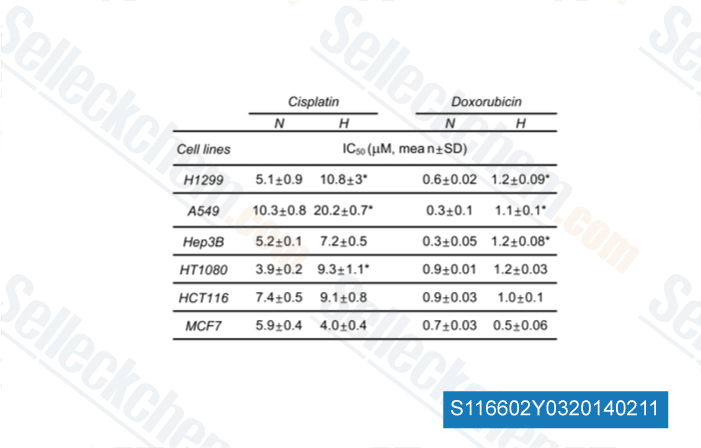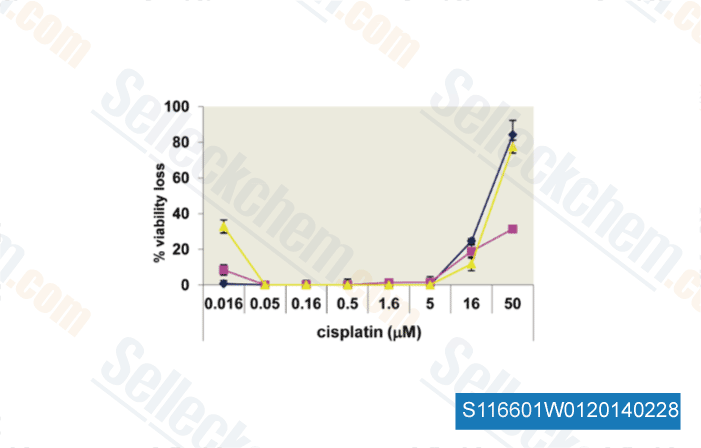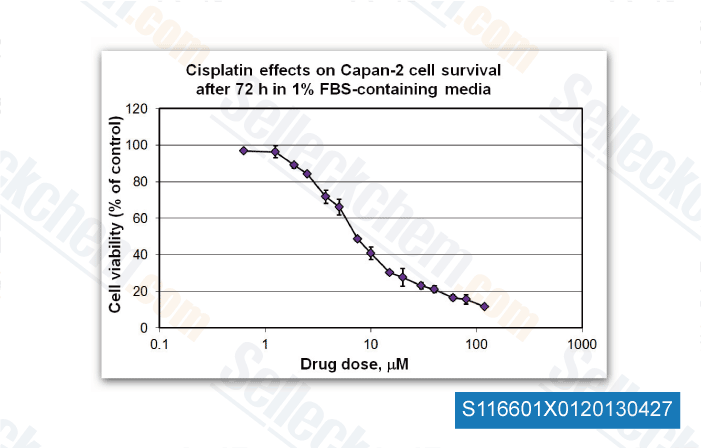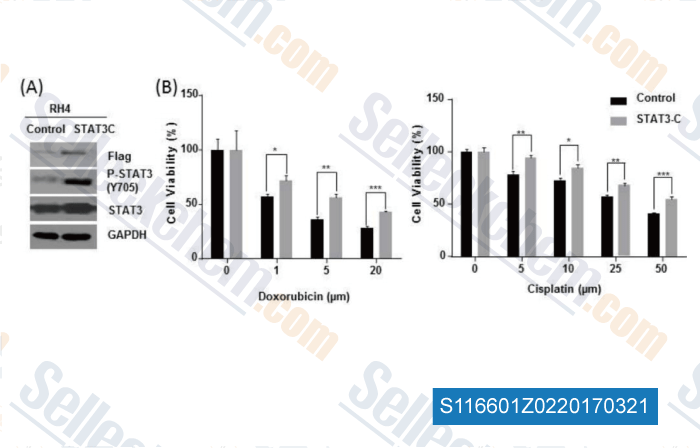|
Toll Free: (877) 796-6397 -- USA and Canada only -- |
Fax: +1-832-582-8590 Orders: +1-832-582-8158 |
Tech Support: +1-832-582-8158 Ext:3 Please provide your Order Number in the email. |
Technical Data
| Formula | Cl2H6N2Pt |
||||||
| Molecular Weight | 300.05 | CAS No. | 15663-27-1 | ||||
| Solubility (25°C)* | In vitro | DMF | 15 mg/mL (49.99 mM) | ||||
| Water | Insoluble | ||||||
| Ethanol | Insoluble | ||||||
| In vivo (Add solvents to the product individually and in order) |
|
||||||
|
* <1 mg/ml means slightly soluble or insoluble. * Please note that Selleck tests the solubility of all compounds in-house, and the actual solubility may differ slightly from published values. This is normal and is due to slight batch-to-batch variations. * Room temperature shipping (Stability testing shows this product can be shipped without any cooling measures.) |
|||||||
Preparing Stock Solutions
Biological Activity
| Description | Cisplatin is an inorganic platinum complex, which is able to inhibit DNA synthesis by conforming DNA adducts in tumor cells. Cisplatin activates ferroptosis and induces autophagy.Solutions are unstable and should be fresh-prepared.DMSO is not recommended to dissolve platinum-based drugs, which can easily lead to drug inactivation. | |
|---|---|---|
| Targets |
|
|
| In vitro | Cisplatin induces cytotoxic by interaction with DNA to form DNA adducts which activate several signal transduction pathways, including Erk, p53, p73, and MAPK, which culminates in the activation of apoptosis. [1] Cisplatin (30 μM) treated for 6 h induces an apparent activation of Erk in HeLa cells, which is sustained over the following 14 h period. Cisplatin also shows an effective antineoplastic activity by inducing tumor cells death[2]. Cisplatin displays ability to cause renal proximal tubular cell (RPTC) apoptosis, causing cell shrinkage, a 50-fold increase in caspase 3 activity, a 4-fold increase in phosphatidylserine externalization, and 5- and 15-fold increases in chromatin condensation and DNA hypoploidy, respectively. [4] Cisplatin (800 μM) causes typical features of necrosis of RPTC after treatment for 4 hr. [5] |
|
| In vivo | Cisplatin has been demonstrated to be efficient in regression tumor growth in a wide variety of animal tumors models, including head and neck cancer xenografts, cervical squamous carcinoma xenografts, testicular carcinoma xenografts, ovarian cancer xenografts, breast carcinoma xenografts, colonic carcinoma, heterotransplanted hepatoblastoma, and so on. Cisplatin (5 mg/kg) given weekly i.v. at the day 1 and 7 induces a tumor growth inhibition (GI) of 77.5% and 85.1% of the serous xenografts Ov.Ri(C) and OVCAR-3, respectively. [6] |
|
| Features | One of the most widely used and most potent chemotherapeutic agents. This product is not recommended to be dissolved in dimethylsulfoxide (DMSO).[7] |
Protocol (from reference)
| Cell Assay: |
|
|---|---|
| Animal Study: |
|
References
Customer Product Validation

-
Data from [Cancer Res, 2014, 74(1), 298-308]

-
Data from [PLoS One, 2013, 8(1), e54595]

-
, 2013, Dr. Edita Aksamitiene from Thomas Jefferson University

-
Data from [Data independently produced by , , Curr Cancer Drug Targets, 2016, 16(7):631-8]
Selleck's Cisplatin has been cited by 737 publications
| FLIP(C1orf112)-FIGNL1 complex regulates RAD51 chromatin association to promote viability after replication stress [ Nat Commun, 2024, 15(1):866] | PubMed: 38286805 |
| Comprehensive multi-omics analysis reveals WEE1 as a synergistic lethal target with hyperthermia through CDK1 super-activation [ Nat Commun, 2024, 15(1):2089] | PubMed: 38453961 |
| SIRT1 ISGylation accelerates tumor progression by unleashing SIRT1 from the inactive state to promote its deacetylase activity [ Exp Mol Med, 2024, 56(3):656-673] | PubMed: 38443596 |
| FAK Drives Resistance to Therapy in HPV-Negative Head and Neck Cancer in a p53-Dependent Manner [ Clin Cancer Res, 2024, 30(1):187-197] | PubMed: 37819945 |
| A novel role for the ROS-ATM-Chk2 axis mediated metabolic and cell cycle reprogramming in the M1 macrophage polarization [ Redox Biol, 2024, 70:103059] | PubMed: 38316066 |
| Inhibiting autophagy enhanced mitotic catastrophe-mediated anticancer immune responses by regulating the cGAS-STING pathway [ Cancer Lett, 2024, 586:216695] | PubMed: 38325769 |
| Induction of IFIT1/IFIT3 and inhibition of Bcl-2 orchestrate the treatment of myeloma and leukemia via pyroptosis [ Cancer Lett, 2024, 588:216797] | PubMed: 38462032 |
| Cisplatin-induced Pyroptosis Enhances the Efficacy of PD-L1 Inhibitor in Small-Cell Lung Cancer via GSDME/IL12/CD4Tem Axis [ Int J Biol Sci, 2024, 20(2):537-553] | PubMed: 38169676 |
| Synergistic antitumor activity between HER2 antibody-drug conjugate and chemotherapy for treating advanced colorectal cancer [ Cell Death Dis, 2024, 15(3):187] | PubMed: 38443386 |
| EFNB1 levels determine distinct drug response patterns guiding precision therapy for B-cell neoplasms [ iScience, 2024, 27(1):108667] | PubMed: 38155773 |
RETURN POLICY
Selleck Chemical’s Unconditional Return Policy ensures a smooth online shopping experience for our customers. If you are in any way unsatisfied with your purchase, you may return any item(s) within 7 days of receiving it. In the event of product quality issues, either protocol related or product related problems, you may return any item(s) within 365 days from the original purchase date. Please follow the instructions below when returning products.
SHIPPING AND STORAGE
Selleck products are transported at room temperature. If you receive the product at room temperature, please rest assured, the Selleck Quality Inspection Department has conducted experiments to verify that the normal temperature placement of one month will not affect the biological activity of powder products. After collecting, please store the product according to the requirements described in the datasheet. Most Selleck products are stable under the recommended conditions.
NOT FOR HUMAN, VETERINARY DIAGNOSTIC OR THERAPEUTIC USE.
